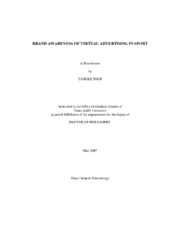| dc.description.abstract | The purpose of this study was to assess the brand awareness levels of virtual
advertising in sport. More specifically, this study explored factors affecting brand
awareness communicated through virtual advertising in a sport broadcast. Particularly,
this study focused on the following factors: baseball involvement, team identification,
animation, and repetition.
To measure consumers’ awareness levels of virtual advertising and to control for
extraneous variables, two 3x3 Latin square designs were adopted. A group in one of the
Latin square groups saw three different brands (Champion, Icehouse, and Mercury)
appearing in different number of exposures (one, four, and six). The other two groups in
the same Latin square groups each saw the same video with different combinations of
number of exposures and brands. The three groups in the other Latin square group each
saw exactly the same three videos, but with animation effects on the virtual
advertisements. A sample of 208 undergraduate students from several physical activity
classes was solicited to participate in the study. They were handed a random CD that
contained one of the six 24-minute video clips of a Texas Rangers game with virtual
advertising embedded. After watching the CD, they were asked to answer an online
questionnaire. Unaided and aided recalls, as well as recognition rates were measured to determine the brand awareness levels of virtual advertising. In addition, items
measuring baseball involvement, team identification (Rangers & Red Sox), brand
involvement, and demand artifacts questions were included in the survey. A series of
sequential logistic regression analyses and analysis of covariance were performed on
the awareness measures.
The results suggest an effect of repetition on unaided recall levels. At the
recognition level, repetition had an interaction with baseball involvement, but no other
effects were found. Additionally, animation was found to be ineffective in attracting
viewers’ attention; however, animation had an interactive effect with repetition on
unaided recall. The effects of baseball involvement and team identification were found
to affect awareness levels, but were inconsistent in prediction. Limitations and future
research questions are discussed. | en |


